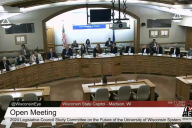You have /5 articles left.
Sign up for a free account or log in.
The number of American students studying in Kuwait recently plunged 50 percent in one academic year -- well, that is, it fell from two to one.
In developing a new study abroad arm, America-Mideast Educational and Training Services, Inc. is counting on that number going up, as well as the number of Americans deciding to study in Egypt, Jordan, Morocco, and Tunisia. Despite that shocking decline in Kuwait, the number of students studying in the Middle East and North Africa has been rapidly increasing, climbing in the Middle East, for instance, 30.8 percent in one year, from 1,977 in 2004-5 to 2,585 in 2005-6, according to data from the Institute of International Education.
Meanwhile, the study of Arabic at U.S. colleges increased 126.5 percent from 2002-6, according to the Modern Language Association.
Yet, while interest is growing, capacity has not kept pace, making AMIDEAST's expansion significant in that the organization hopes to create an extra 500 to 700 study abroad slots within five years, according to its study abroad director.
“There’s this huge increase in interest,” said Jerome Bookin-Weiner, director of study abroad and outreach for AMIDEAST, a nonprofit founded in 1951 headquartered in Washington and with field offices throughout the Middle East and North Africa. The organization managed its first AMIDEAST-branded study abroad program in Morocco last fall, and is developing semester- and academic-year programs starting in 2009 for Egypt, Jordan and Kuwait, in addition to summer options -- an intensive Arabic program in Morocco and a “learn and serve” program in Tunisia.
"One of the big issues for the education abroad field in general is capacity. Capacity to meet the demand of the increasing numbers of students who want to study abroad everywhere -- this is a particular problem in the North African and Arab countries,” Bookin-Weiner said.
Given AMIDEAST's long-term involvement in the region, "There was a role for AMIDEAST to play in helping to meet this demand," Bookin-Weiner continued. "There are particular needs for programs in the region that in a sense can only be met by organizations that have a presence, know their way around."
AMIDEAST has not yet announced the university of record that will award academic credit for its study abroad programs. It has developed a consortium of 17 American universities that will provide academic oversight through annual site visits, with each member institution to be represented by an education abroad professional and two faculty members, one who teaches Arabic and one who teaches Middle East and North African Studies. AMIDEAST has also assembled an all-star group of faculty for an Arabic Language Advisory Board: Seven of the members have served as president of the American Association of Teachers of Arabic.
“I think it’s great that [AMIDEAST is] moving into the region. My overall view is that the internationalization of higher education in the United States is wonderful, but we have to get more students to places where they aren’t going,” said Adam Weinberg, executive vice president of World Learning and provost for the School for International Training, which runs study abroad programs throughout the world, including in Jordan, Morocco, Oman and Tunisia.
“It’s absolutely true that there’s increased demand for programs in the Middle East, but it’s also absolutely true that the percentage of students looking to go abroad to the Middle East of the overall population is very small,” said Weinberg. IIE reported in November that 58.3 percent of Americans studying abroad in 2005-6 went to Europe; just 1.2 percent went to the Middle East.
"What we’re worried about is getting more students in the Middle East. I’m not really worried about other providers being there [in terms of competition]. For me that’s a sign that the general field is moving in that direction and that’s great," Weinberg said.
"For sure, more opportunities to study in the Middle East and North Africa are needed," said Peggy Blumenthal, IIE's executive vice president. “This is an area where host country capacity is going to be the real choke point.”
On the flip side, university capacity within the United States is also an issue, Blumenthal continued. While a huge number of universities have added Arabic programs in recent years, many rely only on a single adjunct instructor and don't offer advanced-level courses suitable for students returning from overseas.
“The first choke point is the capacity abroad. The next choke point may be how we sustain those students' interest when they get back to the home campus.”








